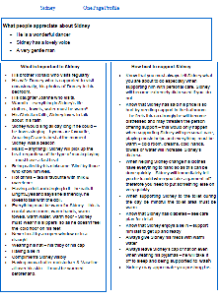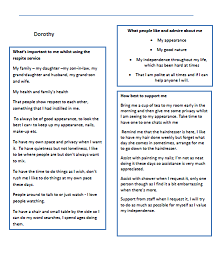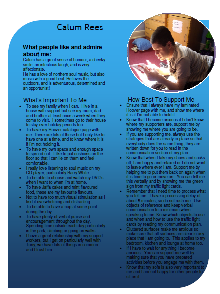A wonderful example of how this mum’s experiences of taking her son to new activities has changed from something quite stressful and often negative to something positive that gives her confidence. George’s one-page profile has changed how people interact with him, communicate with him and think about him – making his involvement in the clubs and activities he loves so much easier than before.
Written by mum Carole
My son George is eight years old. He lives at home with me and his dad and little sister who is five. He loves singing, running and playing computer games. George has a wide range of medical diagnoses and is considered to have a moderate learning disability. He communicates through a mixture of speech and makaton signing.
George is involved in lots of afterschool clubs and activities including swimming, gymnastics and cubs. We’ve always tried wherever possible to include him in mainstream versions of the things he wants to do but had realised for some time that there is often a need to educate people before they are prepared to let him join in. Just filling in the standard forms that come with these sorts of clubs can be a lengthy process involving lots of additional pages and lots of words that can confuse and scare people rather than actually telling them very much about what it is like to spend time with George, what support he needs and what he can give in return.
We decided that a good way to share the important information about George with other people would be to use a one-page profile. We started by thinking about the sorts of questions we usually have to answer about George. We then wrote another list of all the things we wish we could tell people about George and then we asked him what he wanted to tell people about himself. It was quite a job to reduce it to one page, but when we had managed it George chose a photograph of himself that he liked to go in the middle.
We sent it to all of the groups George was attending at the time and also copied it to the people who supported George at school and to those who help us to look after him; family, befrienders and babysitters. We took on board the comments made by the people who knew him well and created a revised version which we then sent back to school with him in the September to introduce him to the new staff. We now attach a copy with applications for every new activity and when someone new starts to support our family.
The first time we used George’s one-page profile was to support a lengthy application form for a church based holiday club that was run entirely by volunteers. I was delighted on the first day to see a photocopy of the one-page profile poking out of the pocket of the lady who had been allocated to George as his one-to-one! Whereas previously I would have been loathed to leave him for at least an hour whilst I ensured this new person had understood everything I wanted them to about George, I was happy to go much sooner as this lady already understood what made him tick. George really enjoyed pointing out the photograph in the middle of the page and told the lady all about where we were when the picture had been taken. This in itself helped me have the confidence that she could understand him well.
We have continued to use it in every similar situation. Most recently we used it on George’s first evening at Cub Scouts. Although he had been a Beaver before, none of those supporting George were making the transition with him, so on the first evening we turned up with George and his one-page profile. George chose a new photo for the middle which was of him in his Beaver uniform because he wanted them to know he had enjoyed Beavers. As I sat filling in the standard application form and asking for extra sheets of paper for all the medical information the Cub Leader read through the one-page profile. When I had finished he stapled the profile to the front of the standard form and said “This will be far more useful, so I think we’ll keep it on the top!”
I watched all sorts of things happen during that first meeting. George was included in a practise for Sports Day events and activities for the Health and Fitness Badge that they were all working towards as if he had been going there for months. At the end of the evening the cubs all stood in their horse shoe for the Grand Howl which is a short ceremony which includes the cubs shouting a response to their leader. When the others began to shout one of George’s new friends helped him to put his hands over his ears to prevent him becoming distressed by the sudden increase in noise…. and I hadn’t said a word!
Since we have had the one-page profile I have felt so much more confident and positive when I turn up somewhere new with George. What had previously been a predominantly negative experience has been turned around. I now know I can get across all the things I want to as well as the things I need to and include in this the things George wants people to know too. He is happy and settling into new activities quickly. He is regularly supported by volunteers and young people who have this information easily to hand.










